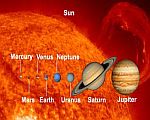- Home
- Really Weird Stuff
- Neutrinos
Neutrinos - the "ghost particles" of the Universe
Neutrinos are tiny particles that propagate throughout the whole Universe. They have almost no mass and no electrical charge, making them very difficult to detect. Because of their properties and elusiveness, they have been variously called "little whisps of almost nothing", "the most tiny quantities of reality ever imagined by a human being", or, more succinctly, "ghost particles".
A Bit Of History
It was back in 1930 that the observation was made that, when a heavy particle such as a neutron decayed into a proton and electron, the amount of energy going in was greater than that coming out. This was impossible, as it violated the Law of Conservation of Energy. Theoretical physicist Wolfgang Pauli therefore proposed the existence of tiny, as yet undiscovered, particles that carried the missing energy away, so the Law wasn't broken.
Three years later, Enrico Fermi gave them their name which, in Italian, means "little neutral one". Trouble was, a lot of the scientific community just didn't believe such particles existed, so they needed to be positively detected. But, because they were theoretically pretty much a bit of almost nothing, how was this going to be possible? The simple answer: with great difficulty.
In fact, this feat wasn't accomplished till 1956. No less than five physicists collaborated in conducting an experiment, using a nuclear reactor. It was thought that neutrinos were created in such places by a process called "beta decay". They would then react with protons to produce neutrons and positrons. The positrons would then interact with electrons, annihilating themselves, giving off gamma rays. The neutrons would be absorbed by suitable nuclei, also producing gamma rays. The successful observation of these two gamma ray bursts then proved the initial presence of the neutrino.
The Three "Flavours"
Next stage in research was the discovery that these tiny particles exist as three different types, called, for some reason, "flavours". The original particles were known as electron neutrinos, as they were associated with the electron. In 1962, a second type was detected, partnered with the muon, another fundamental particle. Both electrons and muons are collectively known as "leptons" and this group of particles also includes the tau. It was therefore thought that this particle would have its own neutrino partner too. It was merely a theory for many years and it wasn't until as recently as 2000 that they were finally detected.
Could there be any more different types? It is not thought so, but this has yet to be conclusively proved.
The Solar Neutrino Problem
For many years since their discovery, these "ghost particles" were thought to be massless, making their nickname even more appropriate. This would mean they would travel at light speed, much like electromagnetic radiation.
It was also known that the centre of stars is a source of these enigmatic little things. Our Sun is producing billions of them continuously and they are constantly passing through our planet - and us!
Scientists attempted to measure the number of them hitting the Earth and were surprised to find that there were less than 50% of the amount expected. This, known as the "Solar Neutrino Problem", puzzled physicists for some 30 years. It became one of the Great Unsolved Problems of Physics...until it was solved at around the turn of the 21st century.
The explanation was that these particles had to be capable of oscillation. That's a physics term that simply means they were capable of changing from one type to another. This would account for the discrepancy as the detector would only be looking for one particular type. But, to be capable of oscillation, the neutrino must therefore possess mass. Another discovery!
The mass of this particle is very small indeed, many millions of times less than an electron.
This also meant that they were not capable of travelling at light speed.
The "Sterile" Neutrino
Recent experiments have, despite what is said above, hinted at the existence of a fourth ghost particle. It has been tagged "sterile" because, if there was such a particle, it would not react with the weak nuclear force, as opposed to the other three, which do.
If the original three basic ghost particles were difficult to detect, then the "sterile" version would be many times harder. If it existed, it is thought that it would be heavier than its three cousins and it has also been postulated that sterile neutrinos could make up a significant amount of dark matter in the Universe.
It's amazing to think that, without the presence of these tiny bits of almost nothing, the Universe wouldn't be able to function.









Facebook Comments
Have your say about what you just read! Leave me a comment in the box below.